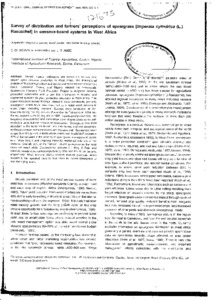| dc.contributor.author | Chikoye, D. |
| dc.contributor.author | Ekeleme, F. |
| dc.contributor.author | Ambe, J.T. |
| dc.date.accessioned | 2019-12-04T11:26:53Z |
| dc.date.available | 2019-12-04T11:26:53Z |
| dc.date.issued | 1999 |
| dc.identifier.citation | Chikoye, D., Ekeleme, F. & Ambe, J.T. (1999). Survey of distribution and farmers' perceptions of speargrass [Imperata cylindrica (L.) Raeuschel] in cassava-based systems in West Africa. International Journal of Pest Management, 45(4), 305-311. |
| dc.identifier.issn | 0967-0874 |
| dc.identifier.uri | https://hdl.handle.net/20.500.12478/4771 |
| dc.description.abstract | Several insects, pathogens and weeds are serious constraints upon cassava production in West Africa. The International Institute of Tropical Agriculture and agricultural research institutions from Benin, Cameroon, Ghana, and Nigeria initiated the Ecologically Sustainable Cassava Plant Protection Project to diagnose cassava production constraints and to use this information to develop and implement sustainable plant protection strategies in West Africa. This paper discusses survey findings related to weed constraints, primarily speargrass, which have been identified as a major weed problem in many crops, including cassava. Surveys were conducted at 241 locations during the dry season (December to February) in 1994 and the wet season (June to August) in 1995 in participating countries. The frequency of occurrence and percentage cover of speargrass varied with ecological zone but not season of assessment. Speargrass was most abundant in the transition forest, mountain forest, and wet savannah, and least common in the rain forest and dry savannah. Speargrass cover ranged from 9% to 79% in fields where it occurred. Available P explained 42% of the variation in the severity of speargrass; management factors (e.g. fallow length and cropping intensity) explained only 5% of the variance. Overall, 50% of the farmers ranked speargrass as the most important weed while Chromolaena odorata (L.) King & Rob. and parasitic weeds were ranked important by 39% and 8% of the farmers, respectively. Most farmers (82%) applied manual practices which needed to be repeated three to four times to reduce speargrass to non-damaging levels. |
| dc.language.iso | en |
| dc.subject | Cassava |
| dc.subject | Weeds |
| dc.title | Survey of distribution and farmer perceptions of speargrass Imperata cylindrica in cassava based cropping systems in West Africa |
| dc.type | Journal Article |
| dc.description.version | Peer Review |
| cg.contributor.affiliation | International Institute of Tropical Agriculture |
| cg.coverage.region | Africa |
| cg.coverage.region | West Africa |
| cg.isijournal | ISI Journal |
| cg.iitasubject | Cassava |
| cg.iitasubject | Weeds |
| cg.accessibilitystatus | Limited Access |
| local.dspaceid | 101594 |
| cg.identifier.doi | https://doi.org/0.1080/096708799227725 |

